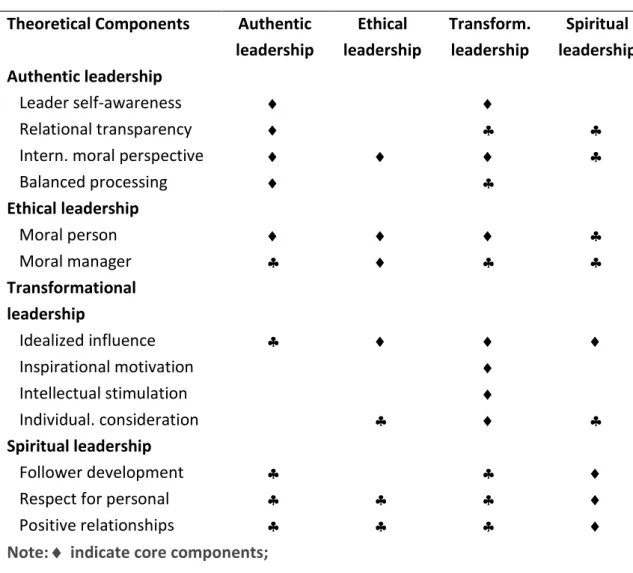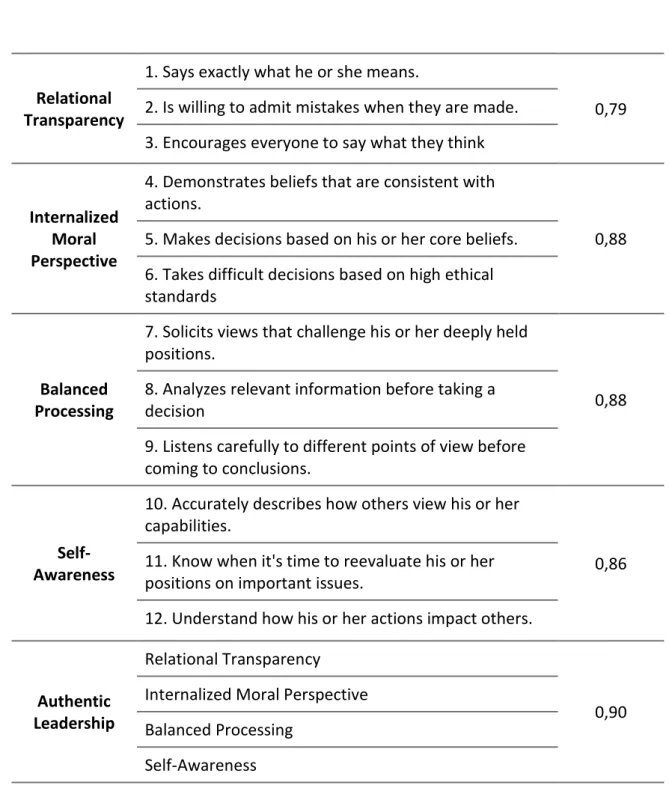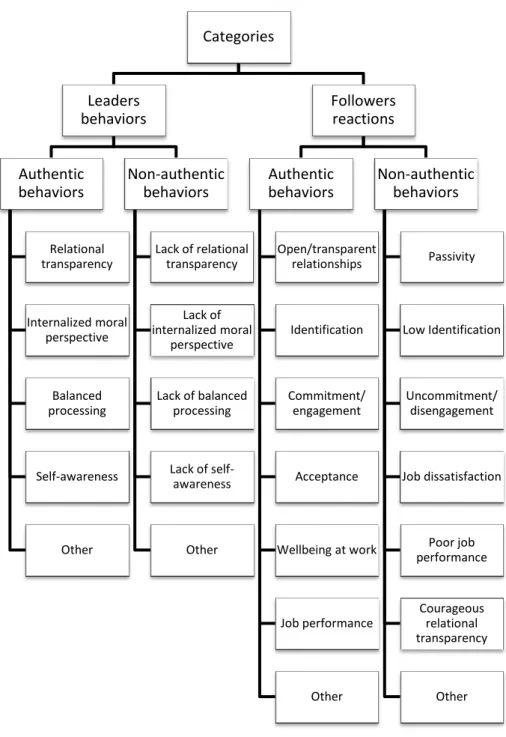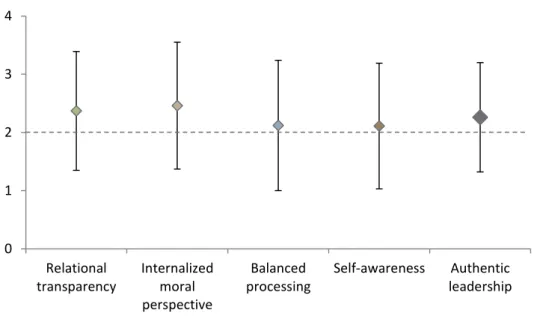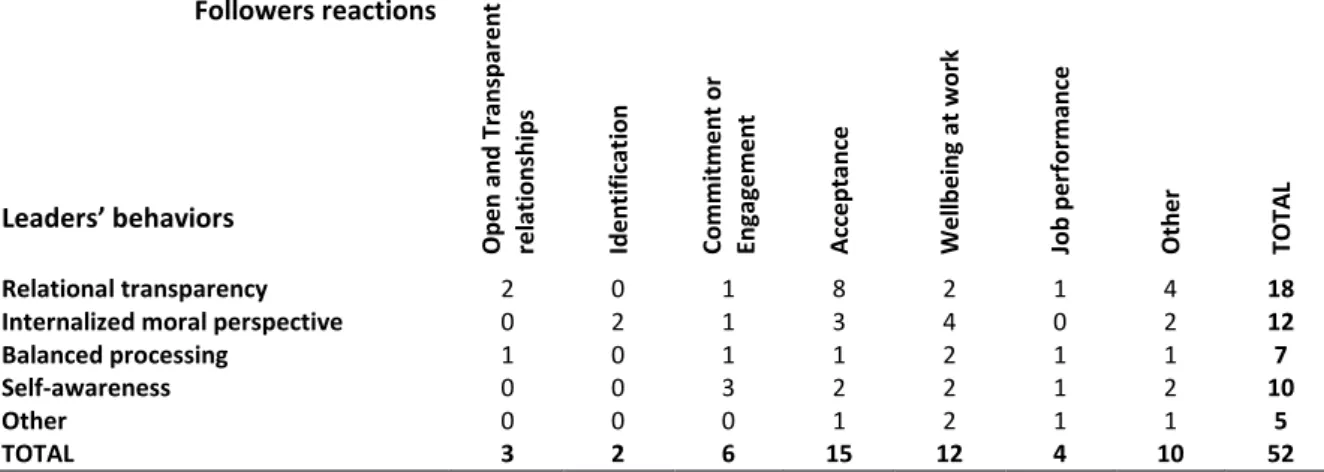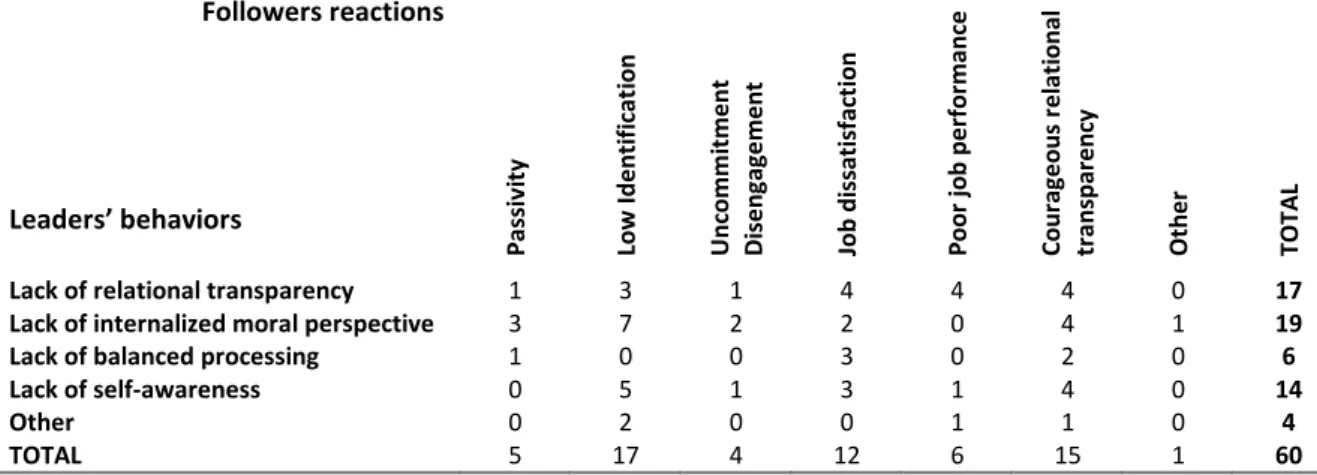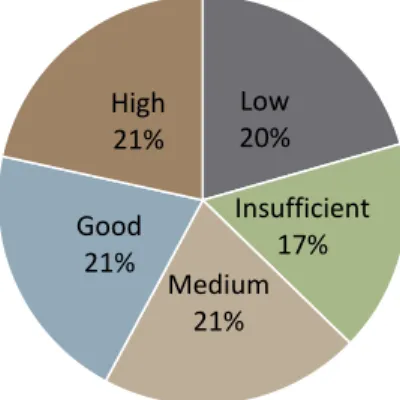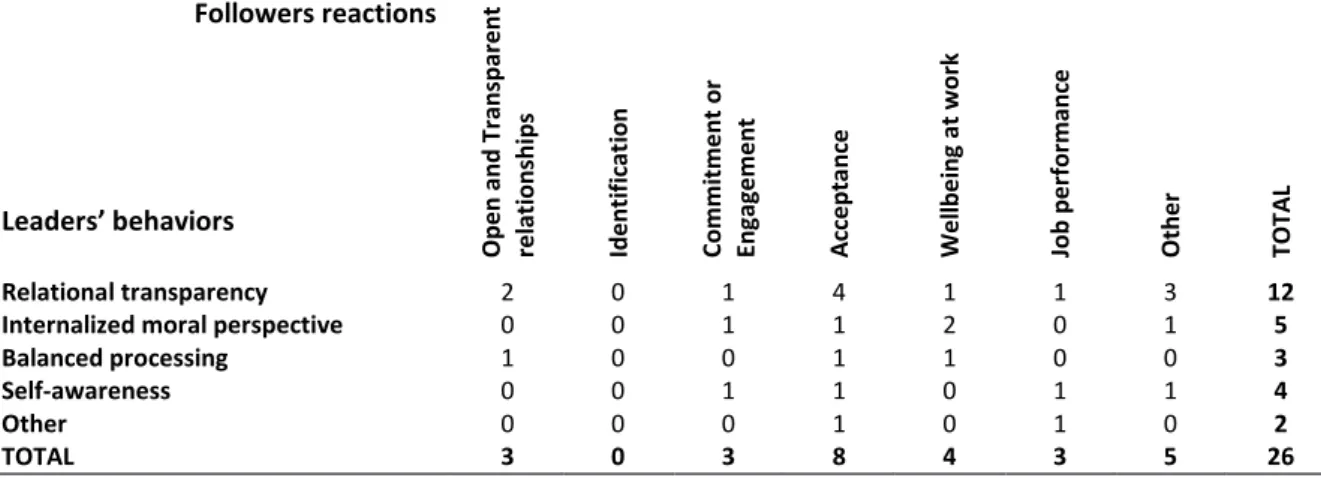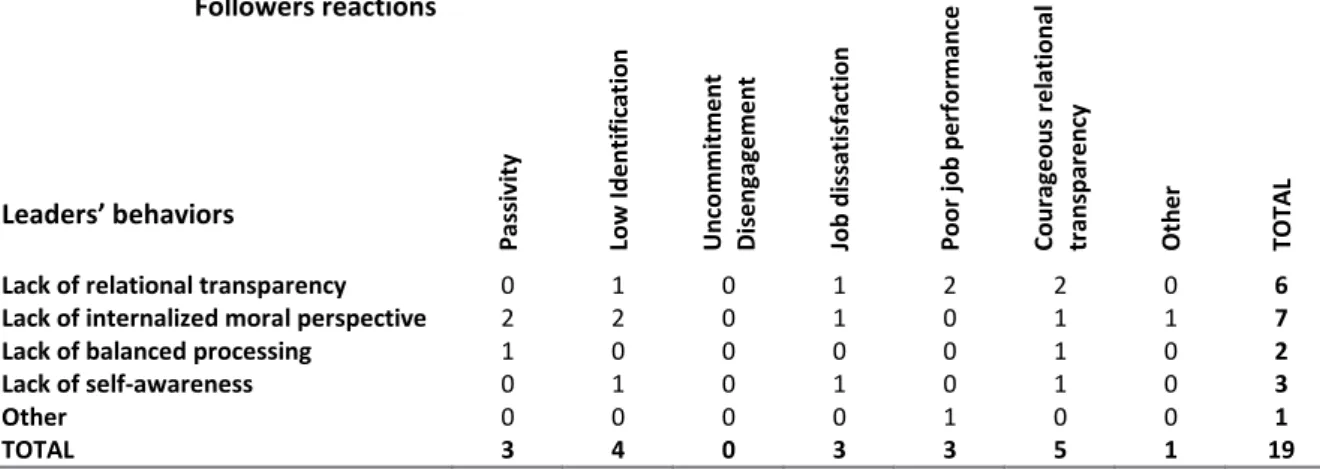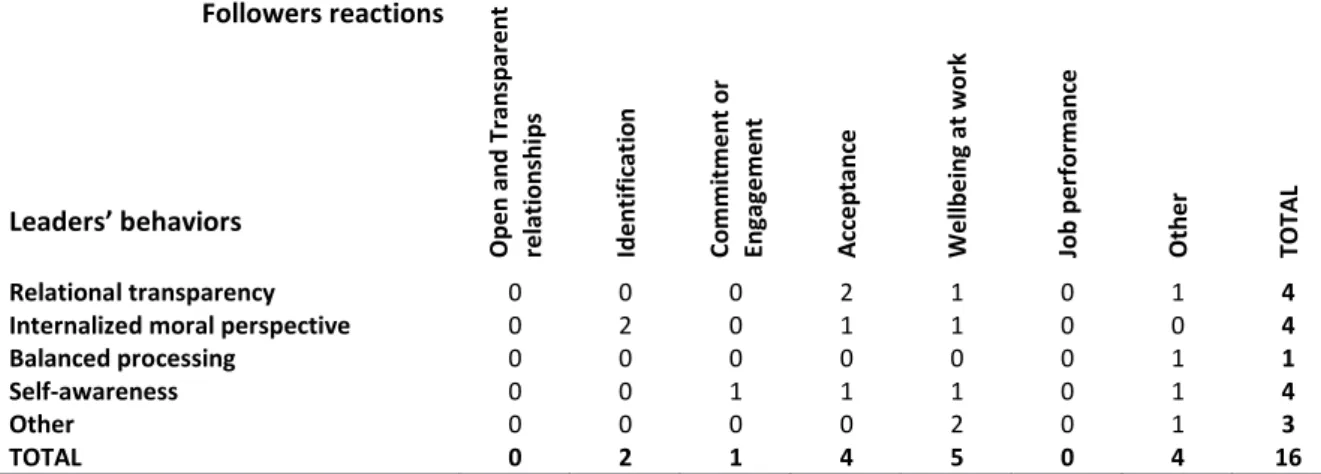Universidade de Aveiro 2012
Departamento de Economia, Gestão e Engenharia Industrial
Victor Fernando
Santos Neto
AUTENTICIDADE DOS LÍDERES E REAÇÕES DOS
LIDERADOS
“AUTHENTICITY OF THE LEADERS AND
REACTIONS OF THE LED”
Victor Fernando
Santos Neto
AUTENTICIDADE DOS LÍDERES E REAÇÕES DOS
LIDERADOS
“AUTHENTICITY OF THE LEADERS AND
REACTIONS OF THE LED”
Dissertação apresentada à Universidade de Aveiro para cumprimento dos requisitos necessários à obtenção do grau de Mestre em Gestão, realizada sob a orientação científica do Doutor José Arménio Belo da Silva Rego, Professor Auxiliar com Agregação do Departamento de Economia, Gestão e Engenharia Industrial da Universidade de Aveiro
iii
"Seja parte da solução, não do problema."
anon.
“Be part of the solution, not of the problem.”
anon.
o júri
presidente Prof. Doutor António Carrizo Moreira
professor auxiliar do Departamento de Economia, Gestão e Engenharia Industrial da Universidade de Aveiro
Prof.ª Doutora Anabela Gomes Correia
professor coordenador do Instituto Politécnico de Setúbal - Escola Superior de Ciências Empresariais
Prof. Doutor José Arménio Belo da Silva Rego
professor auxiliar com agregação do Departamento de Economia, Gestão e Engenharia Industrial da Universidade de Aveiro
v
agradecimentos O autor agradece de forma reconhecida:
Ao seu orientador, o Professor Doutor Arménio Rego; A todos os que responderam ao questionário.
palavras-chave Liderança; Gestão; Autenticidade; Lideres; Liderados.
resumo O objetivo deste estudo é explorar a dimensionalização dos comportamentos de liderança autêntica e compreender o modo como os comportamentos (in)autênticos dos líderes influenciam as reações dos liderados. Para esse efeito, três objetivos “operacionais” são prosseguidos: (1) categorizar os comportamentos de líderes autênticos, (2) categorizar as reações dos liderados, e (3) compreender a relação entre os comportamentos dos líderes e as reações dos seguidores.
Para atingir estes objetivos, foi desenvolvido um questionário composto por três partes, para quantificar o grau de liderança autêntica do líder e situações de liderança autêntica e não-autêntica e as respetivas reações dos liderados. A maioria das situações citadas de comportamentos de autênticos e não-autênticos dos líderes encaixa nas quatro dimensões do constructo de liderança autêntica, tal como apresentado na literatura. No que diz respeito à classificação das reações dos seguidores, a maioria das reações relatadas também se enquadram nas categorias citadas na literatura. Uma série de reações a comportamentos inautênticos podem ser categorizadas como relacionamento transparente corajoso.
Dentro dos comportamentos de liderança autêntica, a ligação mais frequentemente citada é a transparência relacional do líder e a aceitação do seguidor. Relações abertas e transparentes, de identificação e desempenho no trabalho são as reações dos seguidores com uma frequência menor, qualquer que seja o comportamento autêntico do líder. Considerando a reação a comportamentos não-autênticos, a reação mais comum é a falta de identificação pessoal e social com o líder ou organização. A falta de perspetiva moral internalizada e de autoconsciência do líder dão origem a uma reação de não identificação.
Líderes com elevados valores de liderança autêntica parecem comportar-se com transparência relacional. Neste cenário, a ligação mais relatada entre os comportamentos e as reações é a relação entre a transparência relacional e aceitação. Ainda neste cenário, mas na análise dos comportamentos não autênticos, os comportamentos dos líderes mais citados são a falta de transparência relacional e falta de perspetiva moral internalizada. A partir desta ligação, a reação dos seguidores mais comum é o relacionamento transparente corajoso.
Considerando os líderes classificados com os menores valores de liderança autêntica, um comportamento dominante autêntico não foi destacado, nem qualquer relação especial entre os comportamentos e reações. Considerando as situações de liderança não-autênticos, os comportamentos mais referidos são a falta de transparência relacional, a falta de perspetiva moral internalizada e falta de autoconhecimento, e as reações dos seguidores mais citadas são a não identificação, insatisfação no trabalho e relacionamento transparente corajoso.
vii
keywords Leadership; Management; Authenticity; Leaders; Followers.
abstract The goal of this study is to explore the dimensionalization of the behaviors of authentic leadership and understand how the authentic and non-authentic behaviors of the leaders influence the followers reactions. Therefore, three “operational” objectives are pursued: (1) categorize the behaviors of authentic leaders; (2) categorize the reactions of the followers; and (3) understand the relation between the leaders’ behaviors and the reactions of the followers. To achieve the latter goals, a three parts questionnaire was developed, to access authentic leadership measurement of the leader and situations of authentic and non-authentic leadership and the respectively reactions of the led.
The majority of the cited situations of leaders’ authentic and non-authentic behaviors fit within the four dimensions of the authentic leadership construct as presented in the literature. In what concerns the categorization of the reactions of the followers, the majority of the reported reactions also fitted within the categories cited in the literature. A number of reactions to unauthentic behaviors can be categorized as courageous relational transparency.
Within authentic leadership behaviors, the most often linkage is between the leader relational transparency and the follower acceptance. Open and transparent relationships, identification and job performance are followers’ reactions with a low appearance frequency, whatever the authentic behavior of the leader. Considering the reaction to non-authentic behavior, the most common reaction is a lack of personal and social identification with the leader/organization. The leader lack of internalized moral perspective and lack of self-awareness lead to a low identification reaction.
Leaders with high values of authentic leadership seem to behave with relational transparency. In this scenario, the most reported linkage between behaviors and reactions is the relation between relational transparency and acceptance. Still in this scenario, but analyzing the non-authentic behaviors, the most mentioned leaders’ behaviors are lack of relational transparency and lack of internalized moral perspective. From this cross linkage, the most referred follower reaction is courageous relational transparency.
Considering the leaders classified with the lowest values of authentic leadership, a dominant authentic behavior was not highlighted, nor any special relation between behaviors and reactions. Considering the non-authentic leadership situations, the most referred behaviors are lack of relational transparency, lack of internalized moral perspective and lack of self-awareness, and the followers’ reactions more times cited are low identification, job dissatisfaction and courageous relational transparency.
CHAPTER 1 INTRODUCTION 1
1 LEADERS AS BUILDERS OF ORGANIZATION SUCCESS 1
2 LEADERSHIP APPROACHES 2
3 AUTHENTIC LEADERSHIP 4
4 DISSERTATION SCOPE 5
CHAPTER 2 LITERATURE REVIEW 7
1 INTRODUCTION 7
2 AUTHENTICITY 8
3 AUTHENTIC LEADERSHIP 10
4 LEADERSHIP MODELS AND COMPONENTS 13
5 AUTHENTIC LEADERSHIP BEHAVIORS AND FOLLOWERS’ ATTITUDES AND BEHAVIORS 16
CHAPTER 3 METHOD 23
1 INTRODUCTION 23
2 PROCEDURE 23
3 SAMPLE 24
4 AUTHENTIC LEADERSHIP MEASUREMENT 25
5 CONTENT ANALYSIS OF CRITICAL INCIDENTS 27
5.1 AUTHENTIC LEADERSHIP BEHAVIORS 27
5.2 NON-AUTHENTIC LEADERSHIP BEHAVIORS 29
5.3 FOLLOWERS’ REACTIONS TO AUTHENTIC LEADERSHIP BEHAVIORS 31 5.4 FOLLOWERS’ REACTIONS TO NON-AUTHENTIC LEADERSHIP BEHAVIORS 34
CHAPTER 4 RESULTS 37
1 INTRODUCTION 37
2 HOW PARTICIPANTS CHARACTERIZE LEADERS 37
3 LEADERS’ BEHAVIORS AND FOLLOWERS REACTIONS 39
4 LEADERS’ BEHAVIORS AND FOLLOWERS REACTIONS AS A FUNCTION OF AUTHENTIC LEADERSHIP LEVEL 41
4.1 FOLLOWERS’ REACTIONS TO LEADERS SCORED AS HIGHLY AUTHENTIC (ALQ) 42
4.2 FOLLOWERS’ REACTIONS TO LEADERS SCORED AS WEAKLY AUTHENTIC (ALQ) 44
CHAPTER 5 DISCUSSION AND CONCLUSIONS 47
1 DISCUSSION OF MAIN FINDINGS 47
1.1 LEADERS’ BEHAVIORS 48
1.2 REACTIONS OF THE FOLLOWERS 49
1.3 RELATION BETWEEN THE LEADERS’ BEHAVIORS AND THE REACTIONS OF THE LED 50
2 LIMITATIONS AND FUTURE STUDIES 51
APPENDIX 53
1 QUESTIONNAIRE 53
ix
List of figures
FIGURE 1 - STUDIED SUB-SECTIONS. ... 28
FIGURE 2 - AUTHENTIC LEADERSHIP DIMENSIONS MEAN VALUES ... 38
FIGURE 3 - AUTHENTIC LEADERSHIP MEASUREMENT DISTRIBUTION. ... 41
List of tables
TABLE 1 – DEFINITION OF THE AUTHENTIC LEADERSHIP DIMENSIONS. ... 5TABLE 2 - COMPARISONS OF AUTHENTIC LEADERSHIP WITH OTHER LEADERSHIP THEORY. ... 14
TABLE 3 - AUTHENTIC LEADERSHIP BEHAVIOURS’ AND THEIR EFFECT ON FOLLOWERS’ REACTIONS AND BEHAVIORS. ... 21
TABLE 4 - AUTHENTIC LEADERSHIP MEASUREMENT – ITEMS AND RELIABILITIES. ... 26
TABLE 5 - AUTHENTIC LEADERSHIP BEHAVIORS. ... 30
TABLE 6 - NON-AUTHENTIC LEADERSHIP BEHAVIORS. ... 32
TABLE 7 - FOLLOWERS’ REACTIONS TO AUTHENTIC BEHAVIORS. ... 34
TABLE 8 - FOLLOWERS’ REACTIONS TO NON-AUTHENTIC BEHAVIORS. ... 36
TABLE 9 – MEAN VALUES, STANDARD DEVIATION AND CORRELATIONS... 38
TABLE 10 - LEADERS’ AUTHENTIC BEHAVIORS AND FOLLOWERS REACTIONS. ... 39
TABLE 11 - LEADERS’ NON-AUTHENTIC BEHAVIORS AND FOLLOWERS REACTIONS. ... 40
TABLE 12 - LEADERS’ AUTHENTIC BEHAVIORS AND FOLLOWERS’ REACTIONS FOR LEADERS SCORED AS HIGHLY AUTHENTIC (ALQ). ... 42
TABLE 13 - LEADERS’ NON-AUTHENTIC BEHAVIORS AND FOLLOWERS’ REACTIONS FOR LEADERS SCORED AS HIGHLY AUTHENTIC (ALQ). ... 43
TABLE 14 - LEADERS’ AUTHENTIC BEHAVIORS AND FOLLOWERS’ REACTIONS FOR LEADERS SCORED AS HIGHLY AUTHENTIC (ALQ). ... 45
TABLE 15 - LEADERS’ NON-AUTHENTIC BEHAVIORS AND FOLLOWERS’ REACTIONS FOR LEADERS SCORED AS WEAKLY AUTHENTIC (ALQ). ... 46
Chapter 1
Introduction
1 Leaders as builders of organization success
The quality of the human resources of an organization is probably the main indicator of its performance and sustainability (Harter et al., 2003a; Harter et al., 2003b). The organization leaders and employees make decisions and take actions every day that impact the success of their organizations. Many of these decisions and actions are influenced by their own internal motivations and actions (Shore et al., 1995).
Leaders have a special role influencing their own and the employee’s motivations and actions, therefore they are a key element of an organization. There is no single definition of what a leader is or should be, or what leadership is. The topic has received attention in thousands of empirical studies, theoretical work, and popular writings. In a recent work, Kort (2008) started by exploring two different definitions of leadership: the “classic” leadership is about one person (the leader) getting other people (the followers) to do something; and leadership is the same as management, this is, the way to get things done (action). At the end, it is concluded that these approaches aren’t entirely realistic. Leadership may be independent of formal hierarchical structures, such as in politics or informal groups. Additionally, as for leadership being the same as management, Peter Drucker and Warren Bennis are
known for the quote1: “Management is doing things right; leadership is doing the right things”. Other authors also support that leadership cannot be unrelated from power and authority (Castanheira, 2010). Northouse (2009) states that despite the different ways in which leadership has been conceptualized, the four key components are central to the phenomenon: leadership is a process, involves influence, occurs in groups, and involves common goals. Collectively, the research findings on leadership from all of these areas provide a picture of a process that is sophisticated and complex. Nevertheless, there is a common agreement that to survive and prosper in today’s turbulent and uncertainty environment, organizations need leaders who are flexible and adaptive (Osborn et al., 2002; Yukl, 2008). Leaders must be able to understand the complex relationships among performance determinants and recognize what can be done to influence them in a beneficial way. They must be prepared to modify their leadership behavior, the competitive strategy, and the formal programs and structures to meet the challenges that confront them with the environment (Yukl, 2008). Moreover, turbulence and uncertainty affects also the led, which look for organizational leaders of character and integrity to provide direction and help them find meaning in their work (Gardner et al., 2005). In fact, these challenges have precipitated a renewed focus on restoring confidence, hope, and optimism; being able to rapidly bounce back from catastrophic events, helping people in their search for meaning and connection by fostering a new self-awareness; and genuinely relating to all stakeholders (associates, customers, suppliers, owners, and communities) (Avolio & Gardner, 2005).
2 Leadership approaches
Leadership is presently depicted in various models. In a recent review paper by Avolio et al. (2009), several different types of leadership were highlighted:
Authentic leadership (a pattern of transparent and ethical leader behavior that
encourages openness in sharing information needed to make decisions while accepting followers’ inputs);
1
Introduction
3
Transformational leadership (leader behaviors that transform and inspire
followers to perform beyond expectations while transcending self-interest for the good of the organization);
Ethical leadership (the demonstration of normatively appropriate conduct
through personal actions and interpersonal relationships, and the promotion of such conduct to followers);
Spiritual leadership (comprising the values, attitudes, and behaviors that are
necessary to intrinsically motivate one’s self and others so that they have a sense of spiritual survival through calling and membership);
Cognitive leadership (a broad range of approaches to leadership emphasizing
how leaders and followers think and process information);
Transactional leadership (leadership largely based on the exchange of rewards
depending on performance);
New-genre leadership (leadership emphasizing charismatic leader behavior,
visionary, inspiring, ideological and moral values, as well as transformational leadership such as individualized attention, and intellectual stimulation);
Shared leadership (an emergent state where team members collectively lead
each other);
Cross-cultural leadership (leadership in a multicultural contexts);
Global leadership (leaders who are able to effectively lead across a variety of
cultures) (House et al., 2002);
E-leadership (leadership where individuals or groups are geographically
dispersed and interactions are mediated by technology).
Additional models could be added to the list. All of these different models share components between them, but in general result of a more holistic theorization of leadership. Researchers explore a broad range of angles, including in their models the leader, the follower, the context, the levels, and their dynamic interactions (Avolio et al., 2004; Avolio et al., 2009; Harter et al., 2003a; Harter et al., 2003b; House et al., 2002; Osborn et al., 2002; Rego et al., 2008; Yukl, 2008; Zhu et al., 2004).
Whit these broadband interactions, it is important to study the leaders behaviors and followers reactions, in order to better understand their consequences in the overall performance of an organization and promote the development of a more accurate strategic leadership behavior (Avolio & Mhatre, 2012). In this study, the Authentic Leadership (AL) will be focused.
3 Authentic Leadership
There is growing evidence that an authentic approach is desirable and effective for achieving positive and enduring outcomes in organizations (Walumbwa et al., 2008). As referred above, authentic leaders are defined as having transparent and ethical behavior, encourage openness in sharing and accepting information to make decisions, nevertheless, one is not completely authentic nor completely non-authentic. Thus, the Authentic Leadership construct comprises four dimensions: (1) relational transparency; (2) internalized moral perspective; (3) balanced processing; and (4) self-awareness. Table 1 presented a definition of each of this dimensions.
Although theoretical evidence about Authentic Leadership is plenty, empirical evidence is still scarce, mainly in the Portuguese context.
In this study, it is aimed to test if the four dimensions referred above are reflected in the people’s minds when they think about an authentic leader. It is also wanted to investigate how (in)authentic leadership behaviors influence the followers’ reactions. Finally, it is explored the degree to which authentic and (in)authentic leaders adopt inauthentic and authentic behaviors, respectively. It is considered that it is important to see Authentic Leadership as a complex phenomenon that should not be approached through “simplistic” lens.
Authentic leaders may sometime adopt less authentic behavior, and inauthentic leaders may sometimes behave authentically.
Introduction
5
Table 1 – Definition of the Authentic Leadership dimensions.
Relational transparency A leader that openly shares information and express true thoughts, opinions and feelings.
Internalized moral perspective A leader who is guided by high moral standards, based on values and ethics, and not on social and organizational pressure. Their behavior and decisions are consistent with the values shown
Balanced processing A leader that objectively analyze all relevant information before making a decision. Ask others to challenge their deeply entrenched positions and opinions, this is, are courageous and open-minded.
Self-awareness A leader that shows his vision and sense of the world, recognizes and understands his own strengths and weaknesses, and is aware of how others see him and the impact he has on others. Source: (Avolio & Gardner, 2005; Gardner et al., 2005; Kernis, 2003; Vitória, 2010; Walumbwa et al., 2008)
4 Dissertation scope
Three main objectives are to be achieved within this dissertation thesis. (1) Categorize the behaviors of authentic leaders as perceived by a sample of Portuguese individuals; (2) categorize the reactions of the followers; and (3) understand the relation between the leaders behaviors and the reactions of the followers.
The attain these objectives, the authentic leadership model developed in the literature will be used to explore the effect of different degrees of authenticity on the follower’s behavior. A quantitative and qualitative approach will be used. The quantitative methodology will assist the validation of the authentic leadership model constructs and the definition of the degree of authenticity of the leader according to their follower. Then the qualitative methodology will collect authentic and non-authentic leader’s behaviors and the follower reactions to these behaviors. For the qualitative data, the critical incident technique (Flanagan, 1954; Rego et al., 2008) will be used in order to identify how employees react to leadership behaviors that, in their view, are or not authentic.
Briefly, literature about authenticity and authentic leadership will be reviewed (chapter 2), then the research method will be presented (chapter 3) and will be followed by the presentation of the results (chapter 4) and their discussion (chapter 5). Finally, the conclusions, limitations and future studies will be highlighted.
Chapter 2
Literature review
1 Introduction
The literature is wide on different theoretical approaches to explain the complexities of the leadership process (Northouse, 2009). Considering the recent research history of conceptualizing leadership, one can observe two distinguished periods (Gaughan, 2001). In the 1960s and 1970s, situational or contingency models proposed by Fielder, Vroom and Yetton, and Hersey and Blanchard, focused on identifying styles and behaviors which were dependent on a range of situational factors. These styles can be described as transactional leadership, this is, leadership based on the exchange of rewards contingent on performance (Avolio at al., 2009). However, in the beginning of 1980s, studies started defending transformational models of leadership (Gaughan, 2001). These models, despite the observance of the behavior of the leader, focused on the perception and need of the staff, in order to highlight leaders’ behaviors that transform and inspire followers to perform beyond expectations while transcending self-interest for the good of the organization (Avolio et al., 2009).
In the past few years, authentic leadership models started being reported in the scientific literature (Avolio et al., 2004; Avolio & Gardner, 2005; Avolio et al., 2009; Avolio & Mhatre, 2012; Cooper et al., 2005; Gardner et al., 2005; Gardner et al, 2011; Gardner & Schermerhorn Jr, 2004; George et al., 2007; Ilies et al, 2005;
Rego et al., 2012; Shamir & Eilam, 2005; Vitória, 2010; Walumbwa et al., 2008; Zhu et al., 2004). Authenticity has been an important theme in philosophical studies since the ancient Greece (Gardner et al., 2005). Avolio and Mhatre (2012) justify the recent interest of psychology, organizational behavior, and leadership scholars on authenticity and authentic leadership because of the advent of ethics violations in several industrial fields and even at government level. Organizations and their leaders seem to present a lack of concern for the consequences of their actions. Gardner and Schermerhorn (2004) refer that the organizations environment are being disrupted with the post 9/11 climate. There is an increase in employee’s anxiety, a decline in loyalty, and mistrust on leaders. Additionally, leaders are presently challenged by the globalization, political and social unrest, rapid technological advances, and societal disappointment over sensational examples of gross corporate misconduct (Enron Corporation scandal or Bernard Madoff Ponzi scheme, just to cite two well-known international cases). Leaders struggling with performance pressure are susceptible to management actions that, although offering the tempting securities of activity and peer identification, often fail to deliver real performance results and may highlight major problems on the human side of organizational dynamics.
Despite the disrupted environment, there are evidence of inspirational effects of low profile but genuine leaders who lead by example in fostering healthy ethical climates characterized by transparency, trust, integrity, and high moral standards. Such individuals are called authentic leaders (Gardner et al., 2005) who are not only true to themselves, but lead others by helping them to also achieve authenticity, leading the way to develop positive ethical environments and sustainable accomplishments.
2 Authenticity
The construct of authenticity or what constitutes an authentic person has been defined and described in several different ways over time (Avolio & Mhatre, 2012; Gardner et al., 2005; Vitória, 2010). It has been defined as the absence of self-deception, which involves actually being true to who you are; characterized by the ability to make individual choices, take responsibility for personal errors, and recognize
Literature review
9
own drawbacks, while working towards the fulfillment of own potential (Avolio & Mhatre, 2012). More recent literature defines refined constructs.
A empirically grounded perspective on authenticity is presented by Kernis (2003) as part of a larger theory on the nature of self-esteem. It was considered that when individuals come to know and accept themselves, including their strengths and weaknesses, they display high levels of stable, as opposed to fragile, self-esteem. Such individuals are also relatively free of the defensive biases displayed by less mature persons and consequently more comfortable forming transparent, open, and close relationships with others. Furthermore, they display authentic behavior that reflects consistency between their values, beliefs, and actions. From this, it was proposed that the construct of authenticity comprised four unique components. These components were awareness, unbiased processing, action, and relational orientation. Awareness is being aware of personal motives, feelings, desires, and other self-relevant cognitions. Such awareness involves a deeper understanding of personal strengths and weaknesses, personality, and the source and nature of personal emotions. Therefore, awareness assists the ability to carry out more consistent and genuine social transactions with others.
Unbiased processing is defined as involving the objective processing of self-relevant information. It complements awareness in the way that it adds an element of objective accuracy to the self and other related knowledge derived from personal sense of self-awareness. Therefore, individuals who are authentic are capable of processing self and other related information with greater accuracy, minimizing distortions, exaggerations, and biases.
The third component of authenticity is actions one takes, and this constitutes the behavioral aspect of authenticity. It involves consistently behaving in a manner that is in accordance with one’s true self. Authentic individuals act in ways that are accurate representations of their beliefs and values. They stay true to their own selves and do not incur in behaviors that are contrary to own beliefs and values.
The fourth component of authenticity is relational orientation, which involves achieving openness and truthfulness in one’s close relationships. Authentic individuals strive to achieve transparent relationships with others. They let others see them as
they really are. This type of orientation results in the development of transparent relationships that are characterized by a high level of trust among the participating parties.
Similarly, Deci and Ryan (2000) asserted that authenticity is achieved when individuals enact internalized self-regulation processes - this is, their conduct is guided by internal values as opposed to external threats, inducements, or social expectations and rewards. Both of these research streams provide impressive empirical evidence of the positive consequences that accrue in terms of physical and psychological well-being to individuals who achieve relatively high levels of authenticity.
Ilies et al. (2005) view authenticity as a broad psychological construct reflecting one’s general tendencies to view oneself within one’s social environment and to conduct one’s life according to one’s deeply held values. At more specific levels, authenticity is manifested in concrete aspects of one’s behavior and existence, such as in leading others.
A noteworthy aspect of the way authenticity has been conceptualized lies in the fact that people are neither completely authentic nor inauthentic. Instead, they can best be described as being more or less authentic or inauthentic. (Gardner et al., 2005)
3 Authentic leadership
A theory of authentic leadership has been built over the last decade from the intersection of the leadership, ethics, and positive organizational behavior and scholarship literatures (Avolio et al., 2004; Avolio & Gardner, 2005; Avolio et al., 2009; Avolio & Mhatre, 2012; Cooper et al., 2005; Gardner & Schermerhorn Jr, 2004; Gardner et al., 2005; Gardner et al., 2011; George et al., 2007; Ilies et al., 2005; Rego et al., 2012; Shamir & Eilam, 2005; Vitória, 2010; Walumbwa et al., 2008; Zhu et al., 2004).
It started to be a process defined by positive psychological capacities and a highly developed organizational context, which leads to a greater awareness and self-regulated positive behaviors of the leaders and the followers, and therefore encouraging positive self-development (Walumbwa et al., 2008). However, several
Literature review
11
authors have expressed concerns about defining authentic leadership as encompassing the positive psychological capacities of confidence, hope, optimism, and resilience. Ilies et al. (2005) proposed a four-component model of authentic leadership, in a very close way to the model proposed by Kernis (2003) for authenticity, that included self-awareness, unbiased processing, authentic behavior (authentic acting), and authentic relational orientation.
Gardner et al. (2005) integrated these various perspectives and definitions and proposed a self-based model of authentic leader and follower development. They presented several definitional, theoretical, and philosophical reasons for rejecting the argument that authentic leadership is ethically neutral. It was emphasized that defining authenticity as involving self-awareness and self-acceptance appears to be conceptually inconsistent with a low level of moral development. Although people may be true to themselves at a modest level of moral development, they are unlikely to possess the capacity for self-reflection and introspection required for a true understanding of themselves (or others). It was pointed that authenticity, as theoretically defined and operationalized by social psychologists, is associated with advanced levels of cognitive, emotional, and moral development. The proposed model focuses on the core self-awareness and self-regulation components of authentic leadership, and was inspired also on Kernis (2003) conception of authenticity and Deci and Ryan (2000) self-determination theory. Several distinguishing features associated with authentic self-regulation processes were identified, including internalized regulation, balanced processing of information, relational transparency, and authentic behavior. The same was applied to the authentic follower.
Avolio et al. (2005) consider that the enclosure of a positive moral perspective characterized by high ethical standards, that guide decision making and behavior, need to also be integrated in the authentic leadership construct.
More recently, Walumbwa et al. (2008) aggregated the former work by Avolio and co-workers (Avolio & Gardner, 2005; Gardner et al., 2005) and Ilies et al. (2005) to consolidate and conceptualized the construct of authentic leadership. The selection was justified because they consider that it is firmly rooted in the extant social psychological theory and research on authenticity; but also because it explicitly
recognizes and articulates the central role of an internalized moral perspective to authentic leadership and its development; and finally because it focuses explicitly on the development of authentic leaders and authentic followers, which make it more perceptible and ultimately something that can be developed in leaders. They consider these features to be crucial requirements for a theory of authentic leadership and its development. The social psychological conceptions of authenticity, by Kernis (2003) and Deci and Ryan (2000), also suggest the two remaining distinguishing and crucial components of authentic leadership theory proposed by Avolio and co-workers (Avolio & Gardner, 2005; Gardner et al., 2005): an inherent moral component and a development focus. Gardner et al. (2005) emphasize that an advanced level of moral development is a requirement for the achievement of leader authenticity.
Shamir and Eilam (2005) diverge from this view and don’t consider the leaders’ values and convictions on their conceptualization of authentic leadership, reasoning that leaders can be “true to themselves” without attaining a high level of moral development or complying with high standards of ethical conduct. Indeed, it is questioned whether authenticity is positive among leaders with narcissistic or dysfunctional personalities, as mentioned early. Authentic leaders are described as having a central component of their concept, achieving a high level of resolution or concept clarity, having concordant goals, and having a self-expressive behavior. Nevertheless, Walumbwa at al. (2008) emphasize that any theory of leader development, but particularly one focused on authentic leadership development, will be incomplete and misguided if it does not contribute to increased awareness and attention to the inherent ethical responsibilities that should be present in the leadership role. They define authentic leadership as a pattern of leader behavior that draws upon and promotes both positive psychological capacities and a positive ethical climate, to foster greater self-awareness, an internalized moral perspective, balanced processing of information, and relational transparency on the part of leaders working with followers, fostering positive self-development. This definition reflects several assumptions that underlie their perspective of authentic leadership.
Literature review
13
4 Leadership models and components
As already mentioned in the introduction, it can be found in the literature different leadership models, based in a number of different theoretical components. Components such as leader self-awareness, relational transparency, internalized moral perspective, balanced processing, morality, followers influence, stimulation and development, respect for personality or positive relationships are commonly used to develop different leadership models, being shared among them. (Avolio et al., 2009; Bass & Steidlmeier, 1999; Brown & Treviño, 2006; Gardner et al., 2011; Nichols, 2008; Rego et al., 2007; Rego et al, 2008; Vitória, 2010; Walumbwa et al., 2008; Zhu et al., 2004)
Table 2 shows a comparison of the core components and minor or implicit components of each theory, as well as the extent to which these components are reflected by other theories, extended from a work by Walumbwa et al. (2008).
Before going deeper in to table 2, it will be useful to better define each component. The four Authentic Leadership dimensions were already defined in table 1 (previous chapter). Ethical leadership is defined by two dimensions: moral person and idealized influence. The first is attributed to a leader seeking to do the right thing personally and professionally and having the attributes of honesty, fairness, integrity, and openness. Moral manager is ascribed to self-disciplined and consistent leaders, in their pursuit of clear ethical standards, which they refuse to compromise even in the face of uncertainty or pressure (Brown & Treviño, 2006; Walumbwa et al., 2008). Leaders with idealized influence tend to place followers’ needs over their own needs, share risks with followers, and demonstrate devotion to a set of underlying principles and values. Inspirational motivation involves motivating and inspiring followers by providing meaning, mutual understanding, and challenge to their work. Intellectual stimulation entails stimulating followers to question assumptions, reframe problems, and approach old situations in completely new ways. And Individualized consideration is attributed to leaders who pay attention to followers’ individual needs for achievement and growth by acting as a coach or mentor, creating learning opportunities, and fostering a supportive climate for individual growth. (Walumbwa et al., 2008)
Table 2 - Comparisons of authentic leadership with other leadership theory.
Theoretical Components Authentic leadership Ethical leadership Transform. leadership Spiritual leadership Authentic leadership Leader self-awareness Relational transparency Intern. moral perspective Balanced processing Ethical leadership Moral person Moral manager Transformational leadership Idealized influence Inspirational motivation Intellectual stimulation Individual. consideration Spiritual leadership Follower development Respect for personal Positive relationships
Note: indicate core components;
indicate minor or implicit component.
Source: (Avolio et al., 2009; Bass & Steidlmeier, 1999; Brown & Treviño, 2006; Gardner et al., 2011; Nichols, 2008; Rego et al., 2007; Rego et al., 2008; Vitória, 2010; Walumbwa et al., 2008; Zhu et al., 2004)
Follower development refers to the promotion of self-determination and employee personal development. Respect for personal is attributed to leaders respecting the personal and inner life of employees, as well as displaying kindness, compassion, loyalty, and respect. Positive relationships are credited to leaders that promote positive interpersonal relationships and a sense of team community. (Rego et al., 2008) The border between some components is very fade and there is a conceptual overlap between the leadership constructs, which explains the data present in table 2. Comparing authentic and ethical leadership, both theories describe leaders as moral persons who exhibit honesty, integrity, and openness and a desire to do the right
Literature review
15
thing, as table 2 indicates. Moreover, authentic leadership shares the focus on ethical role modeling that is central to the moral manager component of ethical leadership (Walumbwa et al., 2008). Nevertheless, ethical leadership involves a moral transactional focus on moral management that involves using rewards and discipline to hold followers accountable for ethical conduct (Brown & Treviño, 2006). Thus, the moral manager component of ethical leadership is only partially reflected in authentic leadership theory. Authentic leadership theory likewise contains distinctive components that are not considered by ethical leadership theory. Specifically, the focus on self-awareness, relational transparency, and balanced processing all represent features of authentic leadership not captured in operational definitions of ethical leadership.
Transformational leadership is composed of five components: attributed charisma2, idealized influence, inspirational motivation, intellectual stimulation, and individualized consideration (Avolio & Gardner, 2005; Bass & Steidlmeier, 1999; Nichols, 2008). Although authentic leadership is closely related to the four behavioral dimensions of transformational leadership, the proposed dimensions of authentic leadership are not explicitly encompassed by transformational leadership (Walumbwa et al., 2008). The literature points a key distinction to be that authentic leaders are anchored by their own deep sense of self-awareness, this is, they know where they stand on important issues, values, and beliefs, and they are transparent with those they interact with and lead. They display internalized moral perspective and self-regulation by staying their course through difficult challenges and convey to others, often through actions and words, what they represent in terms of principles, values, and ethics (Ilies et al., 2005). Because authentic leaders know themselves and remain true to their values, they choose leadership roles that are consistent with internal self-concepts and goals, such that over time they create high alignment between their internal core beliefs, their self-identity, and their leader role and actions. In this way, authentic leaders serve both themselves and their followers in a simultaneous manner driven by core consistent values (Walumbwa et al., 2008).
2
Attributed charisma has been described as representing leadership impact and reflecting followers attributions, and not necessarily leader behaviour, which is the main focus of this study.
Although the outcomes of authentic leadership for organizations, followers, and other stakeholders will reflect the internal values of the leader, they will not necessarily match the outcomes for transformational leadership, which is often described as developing followers into leaders. To the contrary, authentic leaders are posited to focus on follower development toward achieving authenticity, which may or may not involve serving in a leadership role. Although authentic leaders build enduring relationships and lead with purpose, meaning, and value, they may not be described as charismatic or inspirational by others. Because authentic leaders are transparent when dealing with challenges, the process by which followers internalize their beliefs and values may be based less on inspirational appeals, dramatic presentations, symbolism, or other forms of impression management, and more on their character, personal example, and dedication. In contrast, transformational leaders have been shown to transform others and organizations through a powerful, positive vision; an intellectually stimulating idea; attention to uplifting the needs of followers individually; and having a clear sense of purpose. (Bass & Steidlmeier, 1999)
Spiritual leadership suggests that leaders values, attitudes, and behaviors, namely the respect for the individual, may influence the followers needs for spiritual survival, the need to feel that one makes a difference through service to others and of belonging (Rego et al. 2008), leading to follower development and the creation of positive relationships. Authentic leadership model conjugates these components, but add distinctive components that are not considered by spiritual leadership. The focus on self-awareness, relational transparency, and balanced processing all represent features of authentic leadership not completely considered in the spiritual leadership model.
5 Authentic leadership behaviors and followers’ attitudes and
behaviors
The nature of the leader–follower relationship influences the overall organization performance (Fisk & Friesen, 2012). Authentic leaders are described as determined to achieve authenticity through self-awareness, self-acceptance, authentic behavior, and open and transparent relationships. The same was applied to describing the authentic follower, who in interactions with the leader not only developed authenticity in him or
Literature review
17
herself, but also in the leader. In the same way, authentic leadership behaviors will influence the follower’s attitudes and behaviors (Avolio & Mhatre, 2012).
Several authors writing on what constitutes authentic leadership have offered several alternate theoretical frameworks and perspectives aimed at describing the multi-faceted aspects constituting authentic leadership. (Avolio et al., 2004; Avolio & Mhatre, 2012; Fisk & Friesen, 2012; Gardner et al., 2005; Gardner et al., 2011; Ilies et al., 2005; Michie & Gooty, 2005; Rego et al., 2012; Yukl, 2008)
A theoretical framework connecting authentic leadership to followers’ attitudes and behaviors has been proposed by Avolio et al. (2004), in their study of the authentic relationship that emerges between an authentic leader and follower, attempting to explain the potential mediating mechanisms that allow authentic leaders to exert their influence on followers’ attitudes, behaviors, and performance.
According to the study, authentic leaders affect their followers’ attitudes and behaviors by creating a sense of personal and social identification among their followers. They use positive role modeling and set high moral standards to connect with their follower’s self-concepts so that their followers’ values and beliefs become more similar to those of their leader. Such leaders are identified by their followers for leading from the front (they don’t delegate, abdicate or relegate), by transparently discussing their mutual vulnerabilities, and by having a constant focus on the growth and development of their followers, as well as themselves. Moreover, by creating an environment that is characterized by high levels of honesty and integrity, they create among followers a sense of pride in belonging to the group, which will motivate followers to personally and socially identify with the authentic leaders and the leaders’ group/organization. Such personal and social identification on the part of the followers leads to high levels of hope, trust, as well as positive emotions and positive states. Trust and positive states/emotions will subsequently lead to higher levels of follower commitment, job satisfaction, meaningfulness, and engagement, which in turn would lead to increased extra effort, job performance and a reduction in withdrawal behaviors by followers. The theoretical framework offered a comprehensive assessment of how the components of authentic leadership related to mediators and
moderators, and how each related to the followers’ authenticity and their performance. (Avolio et al., 2004)
The former theoretical framework was later extended by outlining the various components associated with the process of authentic leadership (Avolio & Gardner, 2005). To fully examine core constructs comprising authentic leadership in action, along with its subsequent impact involved an examination of 9 major facets associated with the authentic leadership process. They were (1) Positive psychological capital including the psychological states of efficacy, hope, optimism, and resiliency, (2) Positive moral perspective, (3) Leader self-awareness, (4) Leader self-regulation, (5) Leadership processes/behaviors, (6) Follower self-awareness/regulation, (7) Follower development, (8) Organizational Context, and (9) Veritable and sustainable performance beyond expectations. It is important to distinguish this 9 facets associated with the authentic leadership process from the 4 core constructs comprising authentic leadership in that the 9 components encompass the entire process associated with authentic leadership and in part its development. Specifically, the process of authentic leadership minimally includes an authentic leader, his or her followers, the relationships between the two, the context and the outcomes that follow as a result. Whereas, the 4 constructs describe what constitutes the composition of an authentic leader.
According to Avolio & Mhatre (2012), this proposed framework assisted the development of the research process on authentic leadership in three important ways: (a) it presented a relatively comprehensive list of the elements associated with the emerging theory on authentic leadership thus supporting a more structured and organized efforts at subsequent theory development; (b) it offered a multi-level framework for examining authentic leadership that included the leader, follower, context and performance; and (c) it provided a broader platform for examining the discriminant validity of authentic leadership by comparing and contrasting it with other leading leadership frameworks such as the transformational leadership theory, ethical leadership theory, the charismatic leadership theory, and theories of servant leadership, and spiritual leadership.
Literature review
19
Further developments by Gardner at al. (2005), focused on the follower component within a more dynamic authentic leadership framework, offering a multi-level self-based perspective of authentic leadership that also examined follower development. The concept of ‘authentic followership’ as an integral component of authentic leadership development was introduced. Special attention was given to the process through which authentic leaders use positive role modeling to create authentic followers who possess high levels of self-awareness and who practice self-regulatory behaviors that would mirror the values and beliefs of their authentic leaders. This mirroring of values and beliefs does not in any way discourage disagreements between authentic leaders and their followers because followers expect their authentic leaders to be transparent with them, to be fair when receiving criticism, to treat feedback with the highest moral standards, and to use that feedback to enhance their self-awareness. It is more a reflection of the fact that authentic leaders attempt to develop authentic transparent relationships with their followers where followers are free to remain true to their own core values and beliefs, while ultimately modeling their leader to display the same qualities with their peers and followers. It may also be the case, which the follower becomes a role model for the leader modeling aspects of authentic leadership that the leader then adopts.
It is also suggested that personal history and trigger events act as antecedents of both authentic leadership and authentic followership and the authentic relationship that results leads to outcomes of follower trust, engagement, workplace well-being, and sustainable and veritable performance. Including context in their discussion, they also examined the role played by an ethical and strengths-based organizational climate in fostering the development of authentic leaders and followers.
These theoretical frameworks are very close to the one proposed by Ilies et al. (2005) where it is proposed a multi-component model of authentic leadership and follower development. Similar to the other work on authentic leadership, they described the 4 elements comprising authenticity, as well as the processes through which authentic leadership impacts the eudaemonic well-being of leaders and their followers.
Table 3 presents a summary of authentic leadership behaviors reported in the latter literature, as well as of the reactions authentic behaviors tend to stimulate on
followers’ attitudes and behaviors. Besides the four main behaviors of authentic leadership: leader self-awareness; relational transparency; internalized moral perspective; and balanced processing, some authors unfold these categories further, highlighting: self-regulated, self-acceptance, open relations or transparent relationships, ethical, honesty and integrity behaviors. The reported reactions that these authentic behaviors may generate on the followers are mainly: self-awareness or even a positive self-development; relational transparency; sense of belonging; personal and social identification; commitment; meaningfulness, engagement and job satisfaction and performance; and even a reduction in withdrawal behaviors.
In this study, it is aimed to test, in the Portuguese context, authentic leadership behaviors as reported by the followers, as well as of the reactions that (in)authentic behaviors tend to stimulate on followers.
In the following chapter, the research method will be presented, namely the investigation procedure will be described, as well as the authentic leadership measurement (content analyses; leaders’ authentic behaviors; leaders’ non-authentic behaviors; followers’ reactions to authentic behaviors; followers’ reactions to non-authentic behaviors) and a description of the sample.
Literature review
21
Table 3 - Authentic Leadership behaviours’ and their effect on followers’ reactions and behaviors.
Authentic Leadership behaviors Followers’ reactions and behaviors
Self-awareness Self-regulated Self-acceptance
Relational transparency Internalized moral perspective Balanced processing Authentic behavior Open relationships Transparent relationships Ethical Honesty Integrity Self-awareness Authentic behavior Open relationships Transparent relationships Positive self-development Pride in belonging to the group Personal identification Social identification Commitment Job satisfaction Meaningfulness Engagement Increased effort Job performance
Reduction in withdrawal behaviors
Source: (Avolio et al., 2004; Avolio & Mhatre, 2012; Fisk & Friesen, 2012; Gardner et al., 2005; Gardner et al., 2011; Ilies et al., 2005; Michie & Gooty, 2005; Rego et al., 2012; Yukl, 2008)
Chapter 3
Method
1 Introduction
In this chapter the research method will be presented. A quantitative and qualitative investigation procedure will be described and will be followed by the description of the content analyses, leaders’ authentic behaviors, leaders’ non-authentic behaviors, followers’ reactions to authentic behaviors, followers’ reactions to non-authentic behaviors, in order to measure the authentic leadership. A description of the sample is also be made.
2 Procedure
The study was carried out in the first semester of 2011, by means of a three part on-line survey. The questionnaire, in Portuguese language, is presented in appendix to this document. Although the questionnaire was available on-line, it was not freely open. All of the responders have been invited in person or by e-mail to fill up the questionnaire, therefore the sample is a convenience one. Additionally, all the participants are Portuguese. A total of 262 persons were invited, of which 104 have replied. The response rate was 39,7%. Of the 104 inquiries, 102 were validated and used for the study.
As referred above, the questionnaire was composed of three parts. The first part used a quantitative methodology to assist the validation of the authentic leadership model
constructs and the definition of the degree of authenticity of the leader according to their follower. The second part was dedicated to the acquisition of qualitative data using the critical incident technique (Flanagan, 1954; Rego et al., 2008). This was used to identify how employees react to authentic and non-authentic leadership behaviors. The last part was dedicated to the characterization of the person filling the form, and included age, gender, academic qualifications and for how long does the person works (or worked) with the described leader. It should be mentioned that the questionnaire was preceded by a sort explanation of the study that was being carried out.
In the critical incident technique, an incident is any observable social activity that is, in itself, suitably to permit inferences and predictions to be made about the person performing the act. To be critical, an incident must occur in a situation where the purpose or intention of the act seems fairly clear to the observer and where its consequences are sufficiently convincing to leave little doubt concerning its effects (Flanagan, 1954). This is an inductive method that needs no hypotheses and in which patterns are formed as they emerge from responses, allowing the researcher to generate concepts and theories (Rego et al., 2008). Respondents are invited to report behaviors in defined situations and the results or outcomes of the behavioral actions. Incidents should be gathered until redundancy appears. It is recommended that a heterogeneous group of respondents are used in order to obtain diverse and exhaustive descriptions from which the classification of behaviors and attitudes can be developed.
It must be noted that the critical incident technique has some drawbacks and limitations. Being retrospective in nature, it may be flawed by recall bias and other undesirable biases, such as consistency factors or memory lapses. For example, it is possible that when thinking about events that took place sometime before the data collection, the respondents reinterpreted the incidents. (Rego et al., 2008)
3 Sample
A total of 262 invitations were made, of which 104 have replied and 102 validated. The third part of the questionnaire was dedicated to the characterization of the
Method
25
respondents, and included age, gender, academic qualifications and the length of contact between the responder and the leader.
Regarding the age distribution of the responders, 94,1% have between 25 and 50 years. The thirty something age group represent 58,8%. The average age of the sample is 36,0 years with a standard deviation of 7,1 years. The sample was composed of 47,1% of women and 52,9% of men. Concerning the academic qualification of the responders, only 7,8% do not have a university level qualification. 49,0% are graduated, 25,5% possess a master degree and 17,6% hold a PhD as their higher qualification degree. Finally, the length of contact between the responders and the leader, this is, for how long does the person work (or worked) with the described leader, 83,3% work with their superior for a time between 1 and 10 years, 10,0% work for less than 1 year, and only 5,9% work with their supervisor for more than 10 years. 31,1% collaborate for a periods of 1 to 2 years, 25,5% from 3 to 5 years, and 26,5% from 6 to 10 years. The average length of the time that the responders work with the leader (length of contact) was of 4,60±4,16 years. It must be noted that from the 102 replies validated, one questionnaire didn’t have the indication of for how long the responder work with the leader being described.
4 Authentic leadership measurement
The authentic leadership measurement used a 12 four-point items adopted from the 16 five-point items of the Authentic Leadership Questionnaire (Copyright © 2007 Authentic Leadership Questionnaire (ALQ) by Bruce J. Avolio, William L. Gardner, and Fred O. Walumbwa. All rights reserved in all media. Distributed by Mind Garden, Inc. www.mindgarden.com). Only 12 items were selected to avoid having a too long questionnaire, once that our study included a quantitative and a qualitative part. The questionnaire measures four dimensions: self-awareness, relational transparency, internalized moral perspective, and balanced processing. The used items are listed in table 4. For the elaboration of the Portuguese questionnaire used in the inquiry, an already translated set of items was used (Rego et al., 2012). Respondents report the
Table 4 - Authentic leadership measurement – items and reliabilities.
Dimension Items Cronbach
alphas
Relational Transparency
1. Says exactly what he or she means.
0,79 2. Is willing to admit mistakes when they are made.
3. Encourages everyone to say what they think
Internalized Moral Perspective
4. Demonstrates beliefs that are consistent with actions.
0,88 5. Makes decisions based on his or her core beliefs.
6. Takes difficult decisions based on high ethical standards
Balanced Processing
7. Solicits views that challenge his or her deeply held positions.
0,88 8. Analyzes relevant information before taking a
decision
9. Listens carefully to different points of view before coming to conclusions.
Self-Awareness
10. Accurately describes how others view his or her capabilities.
0,86 11. Know when it's time to reevaluate his or her
positions on important issues.
12. Understand how his or her actions impact others.
Authentic Leadership
Relational Transparency
0,90 Internalized Moral Perspective
Balanced Processing Self-Awareness
frequency (0: “not at all”; 4: “frequently, if not always”) with which their supervisors adopt the 12 behaviors/attitudes.
All Cronbach Alphas are higher than 0,70. To obtain a composite authentic leadership score: (1) the study averages the items for each of the four subscales to arrive at a
Method
27
composite average for each subscale; (2) then, the study averages the averages for each of the four subscales. Cronbach Alpha is 0,90.
5 Content analysis of critical incidents
The content analysis of the individual qualitative responses was performed for the authentic and non-authentic leaders’ behaviors and the followers’ reactions to those authentic and non-authentic leaders’ behaviors.
Figure 1 display a summary of the categories and subsections which were used to perform the content analysis of the individual qualitative responses.
5.1 Authentic Leadership behaviors
The leaders behaviors were categorized according to the four dimensions presented in the literature: relational transparency; internalized moral perspective; balanced processing; and self-awareness. A category “other” was created to join the few responses that didn’t fit on the latter categories.
Relational transparency is a behavior attributed to a leader that openly shares information and express true thoughts, opinions and feelings. Examples of this behaviors, from the obtained responses are: “when I decided to change my working activity, my supervisor told me exactly what his point of view was and supported my decision”; “the company didn’t have money to pay the Christmas bonus, so the leader, in a meeting, described the situation and the way to solve the problem”; “in the process of performance evaluation, the leader spoke directly with each follower to explain is decision”; or “the leader explained clearly to a client the pros and cons of the product”.
A leader who is guided by high moral standards, based on values and ethics, and not on social and organizational pressure is categorized as having an internalized moral perspective. Examples of this behavior are: “the company’s strategy involved the reduction of some intermediaries in the supply/selling chain. However, the leader refused to "steal" customers’ to existing intermediaries”: “despite some outside
“pressures”, the leader organized the request for tender in an equality way”: “the leader called the attention of a supplier to the fact that some of the components were not charged”; or “although the pressures to carry on with a show event, the leader canceled the event because of a major technical problem”.
Balanced processing is attributed to described behaviors where the leader objectively analyzes all relevant information before making a decision, and/or asks others to
Figure 1 - Studied sub-sections.
Categories Leaders behaviors Authentic behaviors Relational transparency Internalized moral perspective Balanced processing Self-awareness Other Non-authentic behaviors Lack of relational transparency Lack of internalized moral perspective Lack of balanced processing Lack of self-awareness Other Followers reactions Authentic behaviors Open/transparent relationships Identification Commitment/ engagement Acceptance Wellbeing at work Job performance Other Non-authentic behaviors Passivity Low Identification Uncommitment/ disengagement Job dissatisfaction Poor job performance Courageous relational transparency Other
Method
29
challenge their deeply entrenched positions and opinions. Examples of this are: “the leader listens and tries to understand the followers” “the leader asked for help to promote new ideas for a project”; the leader openly asked the followers opinions”; or “the leader shows his point of view but is always ready to listen to others’ opinion”. Self-awareness is a behavior attributed to a leader that shows his vision and sense of the world, recognizes and understands his own strengths and weaknesses, and is aware of how others see him and the impact he has on others. Examples of descriptions assigned to this category are: “given a more complicated surgery, the leader was humble to recognize that the follower had more experience, so he ask him to perform it”; “in a conflict with a client, the leader was able to stay calm and at a high level of politeness”; “he acknowledged that he was wrong in the interpretation of a situation”; or “the leader highlighted to the followers that he also did some mistakes when he was younger”.
Descriptions such as: “the leader rewarded the employers because although he didn’t achieve the selling goal, he was in the edge of it”; “the leader believed in the follower potential and supported him in a hard and long process”; “after a defeat, the leader encouraged everybody”; and “when the good name of company is placed in stake, the leader always supports his team”, are out of the four dimensions that the literature assign to authentic leadership, therefore the were categorized as “other”.
Table 5 synthetizes the Authentic Leadership behaviors.
5.2 Non-authentic Leadership behaviors
Leaders’ non-authentic behaviors were categorized with the inversion of the four authentic leadership dimensions: lack of relational transparency, lack of internalized moral perspective; lack of balanced processing; and lack of self-awareness.
A leader with lack of relational transparency is a leader that does not openly shares information nor expresses true thoughts, opinions and feelings. Examples of responses allocated to this category are: “the leader stated a decision in the board meeting and then withdrew it in a private meeting”; “the leader promised a reward in the future, but then denies it. When confronted with an e-mail stating it, he started doing
